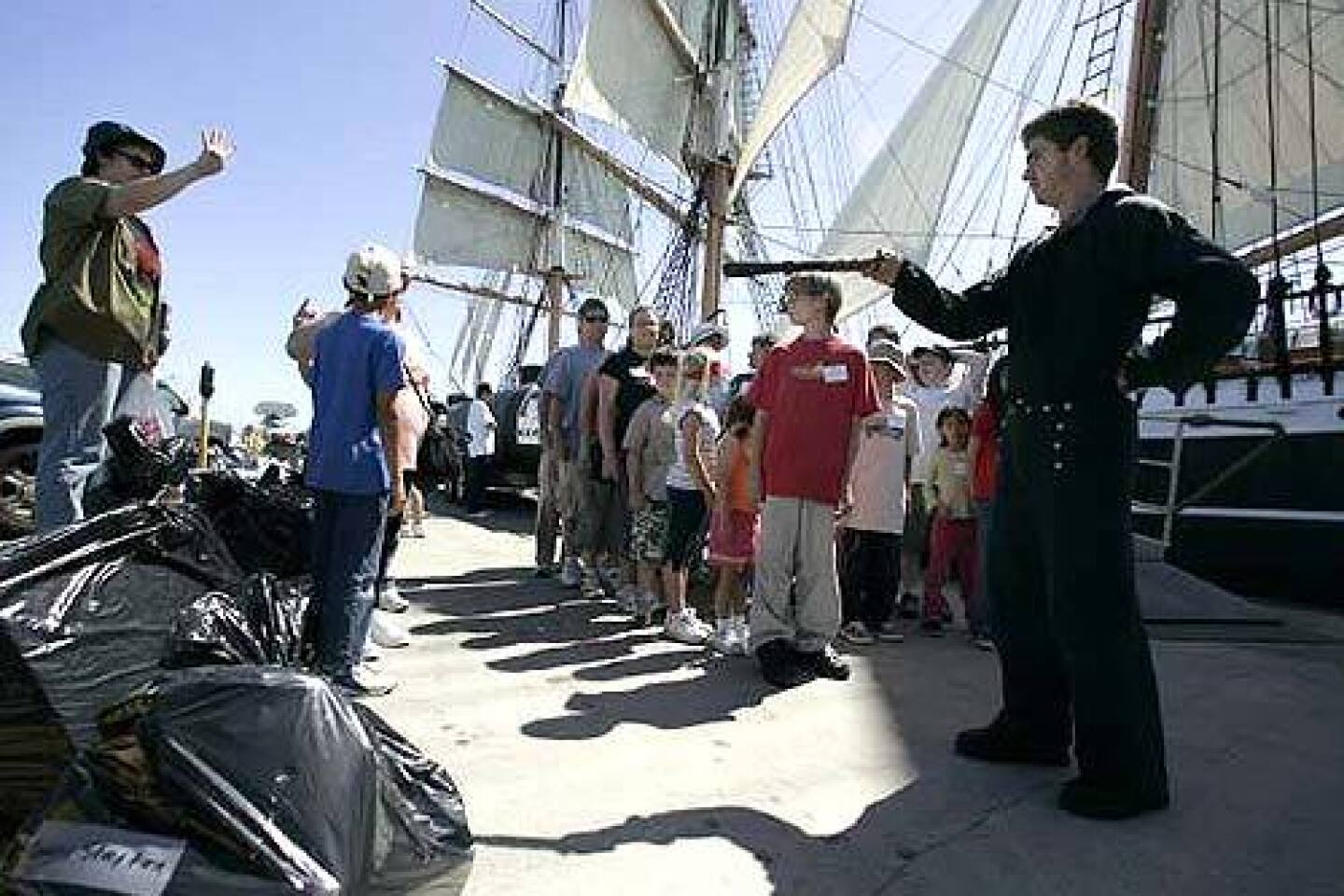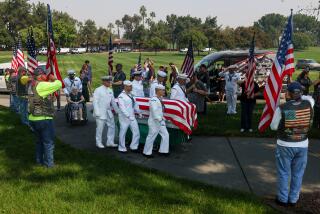San Diego’s popeyed sailors
- Share via
Many Angelenos consider San Diego, with its conservative voting tendencies and picture-perfect downtown scene, another world entirely. But watching my children happily swabbing the deck, moving cargo, raising sails and dutifully falling in line with a respectful “Aye, captain, sir,” well, now we’re talking about another planet, possibly another and more perfectly formed universe.
Certainly we were in another time period. At the Maritime Museum of San Diego, the 30 or so landlubbers preparing to board the Star of India for a Family Overnight one recent Saturday were informed, during a brief but pointed orientation, that the year was officially 1874 and would be for the next 18 hours. So off with the watches and stow the cellphones. Any questions or comments about people, places and things from any year after 1874 would be met with derision by the ship’s officers.
The four veteran sailors who would oversee the experience — Capt. Sorkin, First Mate Mr. Dalton, Mr. Cuatt and Cookie Young, all in period attire, made a few other things clear: There is no such thing as a female sailor, only “long-haired sailors” (girls) and “short-haired sailors” (boys).
Likewise, age made no nevermind aboard the Star of India; the “tall ones” (adults) were expected to pull as much weight as the “small ones,” though neither the captain nor Mr. Dalton was too hopeful because the “tall ones” tended to be the laziest and most mentally deficient sailors on board. (During orientation, children and adults were separated so the adults could be prepared for the gruff way they would be treated and the children reassured that it was only pretend.)
The Star of India is one of the oldest active sailing ships in the world. It is an iron-hulled cargo ship, built on the Isle of Man in 1863 and originally called the Euterpe, after the Greek muse of music. In 1871, it began transporting Europeans emigrating to New Zealand and Australia, making 21 circumnavigations until it was sold again and began sailing from Oakland to the Bering Sea, carrying fishermen and fish.
In 1906, it was renamed the Star of India and in 1923, when steamships became the norm, it ended its commercial career. It languished for years before being fully restored in 1976.
The museum has been providing overnight onboard experiences for students for a dozen years, re-creating a sailor’s life complete with deck-swabbing, night watch and meals of “rat stew.” Three years ago, the experience was opened to families who can participate on one of four summer weekends.
But as Mr. Dalton surveyed the group standing on the dock beside the gangplank at 3 p.m., he was not impressed. “You don’t look much like sailors,” he said, “but I’ll guess you’ll have to do. Are you ready to work hard?” Adults and children alike nodded uncertainly. “The answer is ‘Aye, Mr. Dalton.’ ”
“Aye, Mr. Dalton,” came a feeble chorus.
“Oh you can’t be as weak as that,” he said. “Try again.”
“Aye, Mr. Dalton,” we shouted, with an adult or two throwing in a “Mr. Dalton, sir” for good measure.
The young man’s head swiveled. “ ‘Sir’ is for the captain,” he snapped. “Calling me ‘sir’ is mutiny,” he said with a wink for the younger sailors, “and mutiny is punishable by hanging.”
And so our adventure began.
Getting on board
Divided into crew lines of 10 or 11, ordered about by some of the older children dubbed “masters,” we filed up the gangplank to stow our gear, which consisted of garbage bags full of sleeping bags and pads; small pillows; two changes of clothing and shoes; a plastic bowl, cup and spoon; and a toothbrush.We were among six families whose children ranged from 5 to 13 or so. Our daughter, Fiona, is 5, and I was concerned; the museum recommends that participants be at least 6.
I needn’t have worried. From the start, Fiona and her 7-year-old brother, Danny, neither of them known for their patience or docility, were entranced. They stood in line with no dawdling or horseplay; they answered commands with fervor and respect. They heaved, they ho’ed, they sang sea chanteys and listened raptly to stories of the bounding main.
They asked permission to use the head and kept an eye on the beguiling Mr. Cuatt, who tended to sneak into Cookie’s galley for illicit snacking.
Not that there was much time for the boredom that often provokes bad behavior. With a mixture of banter and directives, Capt. Al Sorkin was able to impose order. Through a course of activities, we learned about the ship and its various incarnations, marveled at the cramped conditions the emigrants endured and the comparative luxury of the cabins for the captain and wealthy passengers.
We also learned about the sailor’s life. Dashing uniforms aside, it was not easy, and children and adults were impressed by the length of the voyages and the discipline required to maintain order. When Mr. Dalton took the cat-o’-nine-tails out of the bag and demonstrated it, eyes grew wide.
Because it was family night, there were fewer children than usual — 15 or so compared with the 30 to 60 students who participate during the school year. This gave the staff a chance to engage us in a broader range of activities. With the “small ones” taking the lead, we hoisted a mainsail, raised and lowered the captain’s skiff, and hauled cargo till our arms ached. The “small ones” were pulled up in the bosun’s chair to clean the mast and sent into the depths of the bilge (the lowest part of the ship) to check for leaks and rats.
About 7 p.m., after four hours of pretty much nonstop and often physically arduous activity (moving cargo was serious business), we were lined up again on deck in preparation for dinner — the fine “rat stew” Cookie had been laboring on all afternoon. (A variation on the beef stew was available for vegetarians.)
After washing the dishes in tin tubs — seeing Danny cheerfully do the family dishes was definitely worth the 2 1/2 -hour drive — we went below to the ‘tween deck for a talk with the captain. Sorkin handed round a series of objects — a lump of iron ore, a ship’s prism, a scrimshawed whale’s tooth — and asked the children to describe them and guess why they were important to those aboard the Star of India.
It was warm and it had been a long afternoon, but after every question, hands shot in the air and there was a miraculous lack of fidgeting. Then it was time for ghost stories, most of which I didn’t hear because by that time I was dozing a bit. (Sorry, captain.)
We could sleep on the ‘tween deck or the upper deck; everyone chose to be outside, where it was cooler, if bright from the museum and city lights. By 10:30, all were in their sleeping bags, most of the adults anticipating a fairly sleep-free night. I slept like a log, as did the kids, but my husband, Richard, who is a nocturnal roamer even at home, found himself wandering the deck in the middle of the night as the fog rolled in.
It was still there when the day began at 6.
Rising to the occasion
Lollygaggers were not allowed. The captain personally roused Fiona, who was so impressed she actually got up right away. (I wonder if Sorkin is available for school days.)Mercifully, there was coffee for breakfast, or “hot tar” as it was appropriately labeled, along with porridge (oatmeal) and muffins. (OK, there weren’t muffins on board in 1874 but, hey, this was supposed to be somewhat of a vacation.) After breakfast, dishes again and then the pump was primed and the decks swabbed, all by brush-wielding, delighted children.
For me, this was the high point. Because now I know that my days as the only person who sweeps the floor in our house are not, as I feared, numberless.
After another story from the captain, it was time to go. And this was when I knew the trip had been a huge success. Not even the prospect of a stop at the gift shop could console my children.
“Can we do it again?” Danny asked. “Can we do it again soon?”
Maybe the museum needs to add a few more family nights to the schedule.
*
(BEGIN TEXT OF INFOBOX)
Bosuns, berths and salty dogs
Expenses for four on this trip:
Star of India
One night aboard $180
Family membership
Maritime Museum, San Diego $65
Meals
Lunch, Anthony’s Fish Grotto
(before boarding) $28
Parking
Metered $7
Total $280
Distance from L.A. 120 miles
TO LEARN MORE:
Maritime Museum of San Diego, 1492 N. Harbor Drive, San Diego, CA 92101; (619) 234-9153, Ext. 126; https://www.sdmaritime.com . Upcoming Family Overnights are June 18, July 9 and Sept. 24. Note: Cost of the overnight without family membership is $65 per person. We saved $15 off the total bill by joining the Maritime Museum.
— Mary McNamara
More to Read
Sign up for The Wild
We’ll help you find the best places to hike, bike and run, as well as the perfect silent spots for meditation and yoga.
You may occasionally receive promotional content from the Los Angeles Times.












